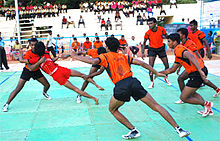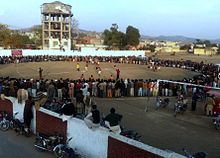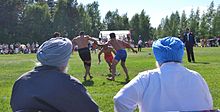Kabaddi

Kabaddi is a contact sport that originated in ancient India. Kabaddi is an umbrella term which encompasses various forms of the game including International rules Kabaddi; Sanjeevani, Gaminee, Amar and Punjabi.[1][2][2][3] Kabaddi also encompasses similar sports known by their regional names, such as hadudu in Bangladesh, baibalaa in Maldives, chedugudu in Andhra Pradesh, sadugudu in Tamil Nadu and hututu in Maharashtra.[4]
Kabaddi is the national game of Bangladesh and also the state game of the Indian states of Tamil Nadu, Maharashtra, Bihar, Andhra Pradesh, Telangana and Punjab.[5] India is the most successful team on the world stage, having won every World Cup and Asian Games title so far, in both men's and women's categories.
Etymology
There is no consensus as to the origins of the word Kabaddi. The word Kabaddi might have been derived from the Tamil word "kai-pidi" (கைபிடி) meaning "to hold hands".[6][7] However, the word might have been prevalent in North India.[8]
History

Kabaddi originated in the southern Indian state of Tamil Nadu, where it is derived from group hunting and village defense.[9][10][11][12] Other forms of Kabbadi originated in northern parts of India.[13][14][15] Although the game is a traditional sport in various parts of South Asia, the modern standardized version identifies kabaddi with Maharashtra where the process of standardizing the rules of kabaddi took place during 1915 through to the 1920s.[16][17][18][19] Though variations emerged and rules were framed, the game’s principal objective remained unchanged.[20]
Modern Kabaddi is therefore a synthesis of the game played in various forms under different names.[21] Kabaddi received international exposure during the 1936 Berlin Olympics, demonstrated by India. The game was introduced in the Indian National Games at Calcutta in 1938. In 1950 the All India Kabaddi Federation (AIKF) came into existence and framed the rules. The AIKF was reconstituted as The Amateur Kabaddi Federation of India (AKFI) in 1972 and the first national tournament for men was held in Chennai.[22]
Kabaddi was introduced to and popularized in Japan in 1979 by Sundar Ram of India, who toured Japan on behalf of Asian Amateur Kabaddi Federation for two months to introduce the game.[23] In 1979, matches between Bangladesh and India were held across India. The first Asian Kabaddi Championship was held in 1980 and India emerged as champion beating Bangladesh. The other teams in the tournament were Nepal, Malaysia, and Japan. The game was included for the first time in the Asian Games in Beijing in 1990 where seven teams took part.
Epics
The earliest form of the game may have originated during the ancient times in Ancient India, including speculations from the Indian epic Mahabharata. For many years, kabaddi was practiced in Indian Vedic schools with earliest references found in writings by Tukaram pointing that Lord Krishna played kabbadi as a boy.[24]
Variations
International

| External videos | |
|---|---|
In the international team version of kabaddi, two teams of seven members each occupy opposite halves of a field of 10 m × 13 m in case of men and 8 m × 12 m in case of women.[25] Each has three supplementary players held in reserve. The game is played with 20-minute halves and a five-minute halftime break during which the teams exchange sides.
The teams take turns sending a "raider" into the other half. To win a point, the raider must take a breath, run into the opposing half, tag one or more members of the opposite team, then return to his home half before inhaling again.[26] The raider will chant "kabaddi, kabaddi" with his exhaling breath to show the referee he has not inhaled.[26] The raider will be declared "out" and will not gain the point if he inhales before returning to his side, or returns without touching an opponent.[26] The tagged defender(s) will be "out" if they do not succeed in catching the raider who tagged them.[26] Wrestling the raider to the ground can prevent him escaping before he needs to inhale.[26]
Defenders may not cross the center line (the "lobby") of the field and the raider may not cross the boundary lines. However, there is one bonus line which can grant extra points for the raider if he manages to touch it and return successfully. Players who are out are temporarily sent off the field. Each time a player is out, the opposing team earns a point. A team scores a bonus of three points (called a "lona"), if the entire opposing team is declared out. At the end of the game, the team with the most points wins. Matches are categorized based on age and weight. Six officials supervise a match: one referee, two umpires, a scorer and two assistant scorers.
Indian

These are four major forms of Kabaddi played in India which are recognized by the amateur federation. In Sanjeevani kabaddi, one player is revived against one player of the opposite team who is out – one out. The game is played over 40 minutes with a 5-minute break between halves. There are 7 players on each side and the team that outs all the players on the opponent's side scores four extra points. In Gaminee style, seven players play on either side and a player put out has to remain out until all his team members are out. The team that is successful in ousting all the players of the opponent's side secures a point. The game continues until five or seven such points are secured and has no fixed time duration. Amar style resembles the Sanjeevani form in the time frame rule. But, a player who is declared out doesn’t leave the court, but instead stays inside, and the play goes along. For every player of the opposition touched ‘out,’ a team earns a point.[27] Punjabi Kabaddi is a variation that is played on a circular pitch of a diameter of 22 meters.[2]
Notable competitions
Asian Games

Kabaddi has been played at the Asian Games since 1990. The Indian team has won all 7 Gold medals. The next most successful team is Bangladesh, which has won 3 silver medals.
Asia Kabaddi Cup
The Asia Kabaddi Cup has been held twice in consecutive years. The Inaugural tournament was held in the year 2011 in Iran. In 2012, the Asia Kabaddi Cup was held in [Lahore Pakistan] from 1 to 5 November. In 2012 ASIA Kabaddi Cup held in Lahore, Pakistan won against India with a technical win after Indian team forfeited the match following a dispute.
Kabaddi World Cup
Kabaddi World Cup was first played in 2004, then in 2007 and then annually from 2010 onwards. A circle format is followed from 2010 World Cup onwards.[28][29] India is the unbeaten champion winning every edition held so far.
Women's World Cup
The first Women's Kabaddi World Cup was held in Patna, India in 2012. India won the championship, defeating Iran in the finals.[30] India retained the title in 2013, defeating debutants New Zealand in the finals.
Pro Kabaddi League
The Pro Kabaddi League was formed in 2014 based on the popular cricket tournament, Indian Premier League. The first edition of the tournament was held in 2014, starting on 26 July 2014, with eight franchises based at eight different cities in India, consisting of players from around the world. The teams in the competition are Jaipur Pink Panthers based at Jaipur, U Mumba based at Mumbai, Bengaluru Bulls based at Bengaluru, Dabang Delhi based at Delhi, Puneri Paltan based at Pune, Telugu Titans based at Vizag, Bengal Warriors based at Kolkata and Patna Pirates based at Patna. The broadcast rights were purchased by the Star Sports Network and maa movies.
UK Kabaddi Cup

Kabaddi received major recognition in the United Kingdom during the 2013 UK Kabaddi Cup. It featured the national Kabaddi teams from India, England, Pakistan, USA, Canada and a local club team sponsored by SGPC. The UK Kabaddi Cup hosts the Punjab Circle Style of Kabaddi.
World Kabaddi League
World Kabaddi League was formed in 2014.[31] The league includes eight teams from four countries – Canada, England, Pakistan & USA – and plays the Punjabi Circle Style of Kabaddi.[32][32] Some of the teams are owned or part owned by actors – Akshay Kumar (Khalsa Warriors), Rajat Bedi (Punjab Thunder), Sonakshi Sinha (United Singhs) and Yo Yo Honey Singh (Yo Yo Tigers). The inaugural league season was played from August 2014 to December 2014.[33] United Singhs (Birmingham, England) won the finals defeating Khalsa Warriors (London, England) in the first season.[34][35]
Popularity
Kabaddi is a popular sport in South Asia. The Kabaddi Federation of India (KFI) was founded in 1950, and it compiled a standard set of rules. The governing body for kabaddi in Pakistan is Pakistan Kabaddi Federation. In Bangladesh, a variation of kabaddi called Ha-Du-Du is popular. Ha-Du-Du has no definite rules and is played with different rules in different areas. Kabaddi is the National Game of Bangladesh and the Amateur Kabaddi Federation of Bangladesh was formed in 1973. Kabaddi-like games are common in certain rural regions of Iran and in these areas it is a popular game for children and adults. In some areas – especially in the center of Iranian plateau, Khorasan and Mazandaran Kabaddi is known as Zu/Zou (Template:Lang-fa), in Gilan as Do-Do (Template:Lang-fa), in Khuzestan as Ti-Ti (Template:Lang-fa) and in Sistan and Baluchestan as Kabaddi/Kabedi/Kavedi/Kaveddi/Kavaddi (Template:Lang-fa).[36] In Iran, the Community of Kabaddi was formed in 1996, in same year they joined the Asian Kabaddi Federation and in 2001 they joined the International Kabaddi Federation. The Iran Amateur Kabaddi Federation was formed in 2004.
Kabbadi is one of the national sports of Nepal. Kabbadi is played and taught at a very early age in most primary schools beginning in the third grade or so in most Nepali schools. Kabbadi was also played by the British Army for fun, to keep fit and as an enticement to recruit soldiers from the British Asian community. Kabaddi was brought to the United Kingdom by Indian immigrants and Pakistani immigrants. The governing body for kabaddi in the United Kingdom is the England Kabaddi Federation UK.
In popular culture
- Films depicting Kabaddi
- Kudumba Thalaivan (1962)
- Little Buddha (1993)
- Pardes (1997)
- Hu Tu Tu (1999)
- Okkadu (2003)
- Kabaddi Kabaddi (2003)
- Ghilli (2004)
- Ajay (2006)
- Kabaddi (2009)
- Vennila Kabadi Kuzhu (2009)
- Chal Dhar Pakad (2010)
- Bheemli Kabadi Jattu (2010)
- Kabaddi Once Again (2012)
- Badlapur Boys (2014)
- Tevar (2015)
- Anime depicting Kabaddi
- Durarara!!×2 Shō (2015)
- Full Metal Panic? Fumoffu (2003)[37]
- Gintama (2006)
- Teekyu (2013)[38]
See also
References
- ^ "Welcome to International Kabaddi Federation". Kabaddiikf.com. Retrieved 17 March 2015.
- ^ a b c Kissa Kabaddi da by Sarwan Singh Sangam Publications ISBN 93-83654-65-1
- ^ "Kabaddi Federation". Kabaddicircle.com. Retrieved 17 March 2015.
- ^ "Games in Maharashtra". maharashtra.gov.in. Retrieved 17 July 2015.
- ^ Gofran Faroqi (2012). "Kabadihear". In Sirajul Islam and Ahmed A. Jamal (ed.). Banglapedia: National Encyclopedia of Bangladesh (Second ed.). Asiatic Society of Bangladesh.
- ^ "kabaddi, etymology". memidex.com. Retrieved 13 July 2015.
- ^ "Kabaddi, definition". wordreference.com. Retrieved 13 July 2015.
- ^ Handbook of Maharashtra State. Directorate of Publicity, Maharashtra. 1960.
- ^ International Sport Management. Human Kinetics. p. 183. ISBN 978-0-7360-8273-0. Retrieved 22 August 2015.
- ^ "Pro Kabaddi league returns". mint. Retrieved 2 August 2015.
- ^ "Kabaddi doping hits world". Telegraph. Retrieved 2 August 2015.
- ^ "Sporting events add fun to festivities". indiannewslink. Retrieved 2 August 2015.
- ^ India: A Travel Survival Kit. 2005.
- ^ Hasan, Amir (1978). The folklore of Buxar.
- ^ Anjaria, Ulka Shapiro (2007). Novel forms: literary realism and imaginations of modernity in India, 1930-1940.
- ^ James H. Mills (2005). Subaltern Sports: Politics and Sport in South Asia.
- ^ Noel Dyck (2000). Games, Sports and Cultures.
- ^ Victoria Williams (2015). Weird Sports and Wacky Games around the World: From Buzkashi to Zorbing.
- ^ Subhas Ranjan Chakraborty, Shantanu Chakrabarti, Kingshuk Chatterjee (2013). The Politics of Sport in South Asia.
{{cite book}}: CS1 maint: multiple names: authors list (link) - ^ "kabaddi | sport | Encyclopedia Britannica". Britannica.com. 22 September 2014. Retrieved 17 March 2015.
- ^ "Welcome to International Kabaddi Federation". Kabaddiikf.com. 30 April 2010. Retrieved 17 March 2015.
- ^ "History of Kabaddi". Amateur Kabaddi Federation of India. Retrieved 31 July 2015.
- ^ "Kot Kalan". Shaheed Bhagat Singh Memorial Sports Club. 11 April 2010. Retrieved 20 May 2015.
- ^ Noel Dyck (2000). Games, kabaddi Sports and Cultures.
- ^ "Rules of Kabaddi". International Kabaddi Federation (IKF). Retrieved 26 August 2014.
- ^ a b c d e "Welcome to International Kabaddi Federation". Kabaddiikf.com. 30 April 2010. Retrieved 16 August 2014.
- ^ "Kabaddi In India: Origins, success and current pitiable state". Sportskeeda.com. 7 March 2014. Retrieved 17 March 2015.
- ^ "Not so easy way forward for kabaddi". Tribuneindia.com. 22 December 2014. Retrieved 17 March 2015.
- ^ Praveen. "Indian Men & Women Won Kabaddi World Cup 2014". Affairscloud.com. Retrieved 17 March 2015.
- ^ "India win first women's Kabaddi World Cup". Hindustan Times. 4 March 2012. Retrieved 4 April 2012.
- ^ Ripley, Dan (6 August 2014). "Kabaddi was once a Trans World Sport favourite but now it's heading for the 02 Arena as WKL forms | Mail Online". Dailymail.co.uk. Retrieved 16 August 2014.
- ^ a b "World Kabaddi League announces team franchise names and logos - IBNLive". Ibnlive.in.com. 24 July 2014. Retrieved 17 March 2013.
- ^ "Home - The official website of World Kabaddi League". Worldkabaddileague.net. 9 August 2014. Retrieved 16 August 2014.
- ^ "United Singhs crowned World Kabaddi League champions - IBNLive". Ibnlive.in.com. 22 November 2014. Retrieved 17 March 2013.
- ^ "Honey Singh's kabaddi team Yo Yo Tigers suspended". Hindustantimes.com. 15 November 2014. Retrieved 17 March 2013.
- ^ محمد تهامی نژاد. "کَوَدّی کَوَدّی یا کَبَدی کَبَدی ؟ | انسانشناسی و فرهنگ". Anthropology.ir. Retrieved 17 March 2013.
- ^ "Full Metal Panic? Fumoffu". Ryuanime. Retrieved 1 May 2016.
- ^ "Teekyu". Gogoanime. Retrieved 1 May 2016.


